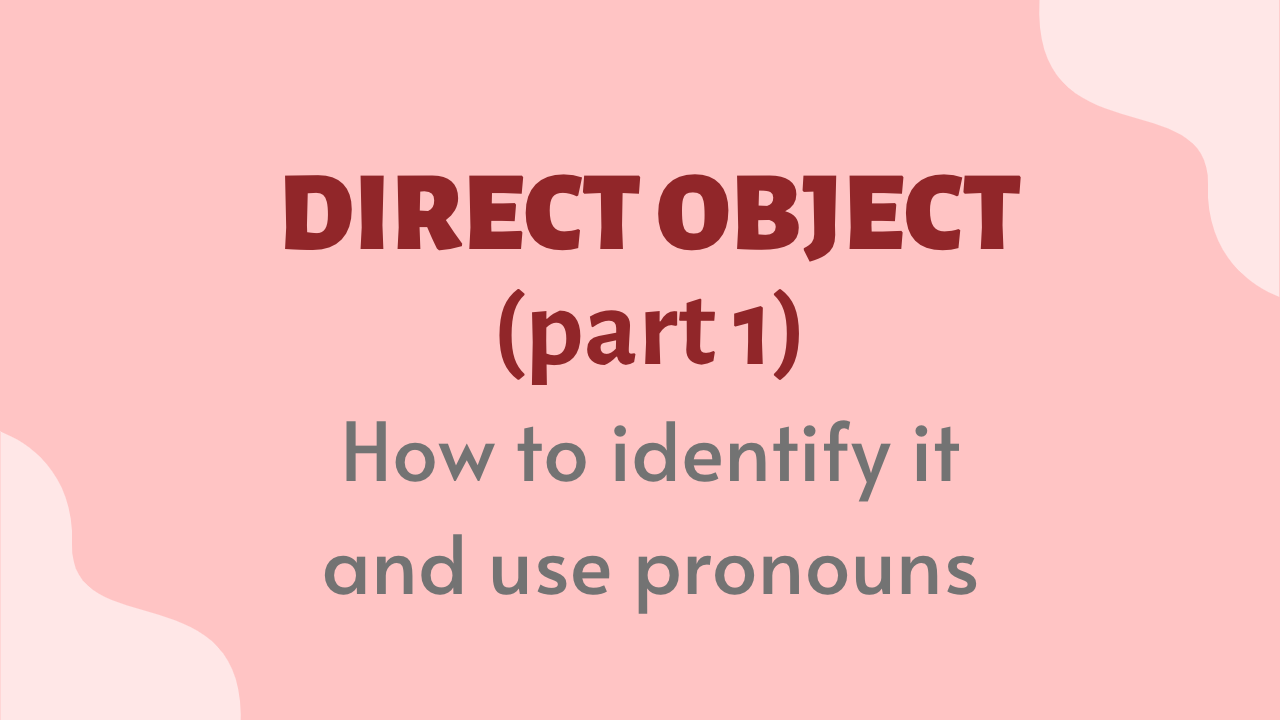During my almost 7 years teaching Spanish to foreigners there is one thing I have come to notice, the class I have to repeat the most is that of direct and indirect objects; regardless of the level, almost all students have serious problems on this subject, especially when they should use pronouns... and more when these appear together!
Therefore, I have decided to create a video and written guide on this subject, in this way you can find answer to your questions whenever you need it.

Direct object, what is it?
Let’s start from the top. To begin to understand the pronouns that we must use, those small and annoying words me, te, lo, la, nos, los, las, le, les; we have to know what the direct object is and what we need it for.
The direct object is a thing or a person who receive the action of the verb directly. I will emphasize the word person. One of the first problems students have is that, after studying indirect objects (which are mostly people) forget that people can be direct objects as well and come to the wrong conclusion that direct objects are just inanimate things.
No. A person and a thing can be direct objects. So how come they get the action directly? Let’s see:
If I say "Luis toca el piano" (Luis plays the piano), piano is a direct object because it is being played directly by Luis.
In the phrase "Ana ama a su madre" (Anne loves her mother), Anne’s mother is directly receiving that love, which makes her the direct object of the phrase.
In the phrase "Luis le toca el piano a Ana" (Luis plays the piano to Ana), the piano is the direct object because it is what is being played. Luis is not playing Ana.
How to identify it?
The easiest way to learn how to identify direct objects is when we ask the verb questions; specifically these two questions: ¿qué? (what?) and ¿a quién? (who?)
Let’s see:
"Luis toca el piano" (Luis plays the piano)
Luis plays, what? The piano.
So piano is the direct object.
"Ana ama a su madre" (Anne loves her mother)
Ana loves, who? Her mother.
So mother is the direct object.
"A" PERSONAL
When the direct object is a person or a pet, you should use a personal "a".
Yo respeto a mi esposa.
Ella ama a su perro.
Mis amigos odian a Felipe.
Now, let’s look at the following sentence:
"Luis va al supermercado" (Luis goes to the supermarket)
The first intuition is to think that supermercado is the direct object, but this is not true. Let’s see why following question system:
"Luis va al supermercado" (Luis goes to the supermarket)
Luis goes, what? This does not seem to be a valid question.
Then let’s try the other one:
Luis goes, who? This is not a valid question either.
The only valid question for the rest of the sentence to be a correct answer is where?
Luis goes, where? To the supermarket.
The problem is where? is not a question for identifying the direct object, so the sentence Luis va al supermercado has no direct object.
Based on the above information, there are two types of verbs:
Transitive verbs
Verbs that admit the presence of direct objects, such as: eat, have, cook, respect, love, read, etc.
Intransitive verbs
Verbs that do not admit direct objects: going, sleeping, traveling, walking, arriving, leaving, etc.
NOT ALL VERBS HAVE DIRECT OBJECTS!
But why do I have to correctly identify the direct object?
Because if you don’t identify it correctly, you’ll never know which pronoun to use; especially when you include indirect objects in your conversation; and if you don’t know how to use pronouns, your phrases will sound like this:
I like chocolate so I buy chocolate to eat after lunch. I don’t want to share chocolate because eating chocolate is my favorite thing in the world.
Ho-rri-ble! That sounds awful in English and Spanish.
It is better to make an effort and learn the use of pronouns.
Ok... So what are the pronouns?
Pronombres de Objeto Directo (POD) work to replace the direct object in a phrase. These are:
- Singular: me (me), te (you), lo/la (you formal, depends on gender), lo (he, it), la (her, it)
- Plural: nos (us), los/las (you guys, depends on gender), los/ las (them, again, depends on gender)
The most common location for POD is before a conjugate verb, then:
I love you.
I love, who? You: the pronoun in Spanish is te; but since we need to use the pronoun before the conjugate verb, the sentence is: Yo te amo.
She respects us all.
She respects, who? Us= nos: Ella nos respeta.
My friend has a car and drives it.
He drives, what? It (the car) = lo (el carro; masculine, singular): Mi amigo tiene un carro y lo maneja.
I have two friends and I call them every day.
I call, who? Them (my friends) = las (mis amigas; feminine, plural): Yo tengo dos amigas y las llamo todos los días.
There are four locations for pronouns in one sentence:
Before conjugated verbs
Yo te amo. (I love you)
Él me respeta. (He respects me)
Yo lo compro. (I buy it)
Attached to the end of an infinitive verb.
Yo quiero comprarlo. (I want to buy it)
¿Puedes ayudarme? (Can you help me?)
Estoy aquí para escucharte. (I'm here to listen to you)
Attached to the end of an affirmative imperative.
Hazlo. (Do it)
Háblame. (Talk to me)
Espéranos. (Wait for us)
Attached to the the end of gerund (-ing).
Tengo un libro y estoy leyéndolo. (I have a book and I'm reading it)
Es una película y estamos mirándola. (It's a movie and we're watching it)
Tú no estás ayudándonos. (You're not helping us)
That's all for now. This is the first part and it’s quite a bit.
If you want the information on video with extra tips, find it here and don't forget to subscribe and like :D
If you want to download this information in an easy to use pdf, you can find it here.
To practice, find exercises here.
See you in part two with the most common mistakes students make using direct objects.
